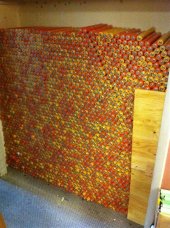I'll be the dissenting voice. I like 2P pairing and have had great luck with my 2P4S battery.
With a 2P16S setup, you have the opportunity (aka a bunch of work) to create equal pairs of cells based on capacities.
So if you have 32 cells of varying capacities, you can make equivalent pairs by pairing the highest capacity with the lowest capacity, second highest capacity with second lowest...
I'm sorry, but this is NOT a good idea. Just to be clear, a 2P16S battery is 16 pairs of cells in series. Each cell in a pair is connected to the other cell, both positive and negative.
The BMS in this case can only read the voltage of each pair. Because they are in parallel, it is reading the
average voltage of the two. If a pair of cells are not the same capacity, the voltage of the lesser will drop more quickly as it approaches empty. This means that the average voltage of the pair can be above the minimum acceptable voltage while one of the cells in the pair is below it. Given that depletion past 0% SOC will damage a cell, you will quickly damage up to half of your cells.
The sole job of the BMS is to keep all the cells from going over or under voltage (as well as managing over voltage and temperature excursions on a pack level). The BMS is designed to stop when any individual cell reaches min or max voltage. Because of this, you need to match the cells in any parallel set (2P, 3P, 4P, whatever) so that these 2, 3 or 4 cells act in lockstep and act as if they were one cell so the BMS can monitor them. If your matched pairs of cells do not match the other matched pairs, this is not a problem, as the BMS will limit the battery to the capacity of the smallest pair. This can work perfectly well especially if the BMS supports active or passive cell balancing or you occasionally top balance them. The balancing will simply keep the top (full) of each pair in sync with the other pairs.
TLDR: Closely match the capacity of each cell in any pair of cells. The pairs do not have to match other pairs. If you have matched pairs of cells a 2p16s battery will work well for many years.






